
All iLive content is medically reviewed or fact checked to ensure as much factual accuracy as possible.
We have strict sourcing guidelines and only link to reputable media sites, academic research institutions and, whenever possible, medically peer reviewed studies. Note that the numbers in parentheses ([1], [2], etc.) are clickable links to these studies.
If you feel that any of our content is inaccurate, out-of-date, or otherwise questionable, please select it and press Ctrl + Enter.
Antibiotic ointments for wounds
Medical expert of the article
Last reviewed: 03.07.2025
To eliminate inflammation and purulent lesions, various antibiotic medications are used. Let's look at popular ointments that are effective for wounds of the skin.
From early childhood, we encounter various skin injuries. In order for the healing process to proceed quickly and not cause various complications, wound healing agents are used. Minor cuts, scratches and abrasions do not require special treatment, but if the wound occupies a large area of the skin, then an ointment with an antibiotic is necessary.
Antibacterial agents for local use are necessary for infectious lesions when suppuration has begun. They have a broad spectrum of action, destroy pathogenic microorganisms. The best option for treatment is a wound-healing ointment with an antibiotic. It helps in the treatment of eczema, chemical and temperature burns, inflammatory-purulent diseases. And also in case of bacterial infection after surgery.
When choosing a drug, it is necessary to take into account that they are classified by etiology and stage of the wound process. So, in the inflammatory process, antiseptics and antimicrobial ointments are used. For deep wounds, antibacterial drugs with an analgesic effect are indicated.
Indications for the use of antibiotic ointments for wounds
The skin is an organ that performs protective functions and prevents pathogenic viruses, bacteria, and infections from entering the body. Indications for the use of antibiotic ointments for wounds are based on the violation of the integrity of the dermis. Let's consider in which cases it is necessary to use the drug:
- Deep cuts and scratches.
- Purulent wounds.
- Abrasions.
- Burns of various etiologies.
- Cracks in the skin with suppuration (on the fingers, heels, elbows).
- Trophic ulcers.
- Ulcers.
- Erosions.
- Chronic dermatoses.
Antibiotic ointments may contain wound-healing substances that speed up the tissue regeneration process. It is better to use the medicine as prescribed by a doctor, especially if the wounds are deep and there is a risk of suppuration.
Pharmacodynamics
You can find out how effective a particular medication is by its pharmacodynamics. Let's consider the mechanism of action of antibiotic ointments for wounds from different pharmacological groups: tetracyclines and chloramphenicols.
- Tetracycline ointment
The bacteriostatic action of the drug is based on the disruption of complex formation between the ribosome of the infectious cell and the transport RNA, which leads to the inhibition of protein synthesis. It exhibits pronounced activity in infectious lesions of the epidermis caused by gram-positive and gram-negative microorganisms. It does not exhibit pharmacological activity against most strains of Bacteroides spp., beta-hemolytic streptococci of group A, fungi and viruses due to the established resistance of these pathogens to the active substances of the drug.
- Levomekol
A combination drug with an antibiotic – chloramphenicol and an immunostimulant – methyluracil. It is active against many bacteria, chlamydia, rickettsia and spirochetes. Its bacteriostatic action is caused by inhibition of protein biosynthesis in the bacterial cell.
Effective against gram-positive aerobic and anaerobic bacteria, gram-negative microorganisms. The peculiarity of this medicine is that the development of resistance of harmful microorganisms to its action occurs slowly. Affects tissue regeneration, has anti-inflammatory properties.
Pharmacokinetics
The therapeutic properties of topical preparations depend not only on their active composition, but also on their pharmacokinetics. Most ointments are quickly absorbed after application to the skin and produce a therapeutic effect.
As a rule, the drugs do not have systemic absorption, so they do not penetrate into the blood, providing a local effect. Long-term use can cause resistance of harmful microorganisms. In this case, it is necessary to change the drug.
Names of antibiotic ointments for wounds
Various skin injuries are a problem known to everyone. Today, there are many drugs for the treatment of wounds and abrasions. To prevent infection and speed up healing, it is recommended to use antibiotic ointments. The choice of drug depends on the level of damage: skin wounds, subcutaneous tissue lesions, deep damage (superficial fascia, muscles, fascial structures).
The doctor should prescribe the medicine. Since its effectiveness depends on the etiology of the wound infection. The most common pathogens are: staphylococci, non-fermenting gram-negative bacteria, hemolytic and non-hemolytic streptococci, obligate non-spore-forming anaerobic microorganisms and others.
Let's look at popular names of antibiotic ointments for wounds, their classification and instructions for use:
Aminoglycosides
- Baneocin
A combined antimicrobial agent for external use. It contains antibiotics (neomycin sulfate, bacitracin) with synergistic properties that destroy bacteria. It is active against most gram-positive and gram-negative microorganisms, fusobacteria and actinomycetes.
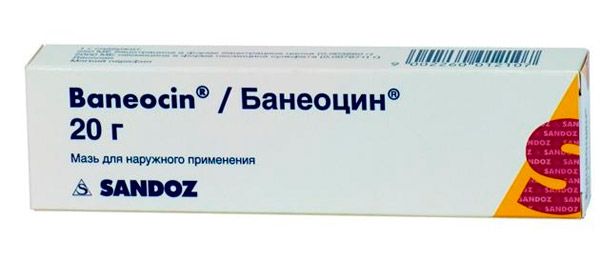
Prevents the development of hypersensitivity to the drug and provides a therapeutic effect from the first days of use.
- Indications for use: treatment and prevention of skin damage and diseases, superficial wounds, burns, bacterial infections, secondary infections. Effective in the postoperative period, in otolaryngology and in pediatric practice for diaper dermatitis.
- Before applying to the skin, it is advisable to check the sensitivity reaction. The product is applied both to the affected area of the skin and under the bandage, since it increases its effectiveness, in a thin layer 2-3 times a day.
- Baneocin is contraindicated for use in case of hypersensitivity to active components, severe damage to the dermis, impaired renal excretory function (with the risk of systemic absorption). It is prescribed with special caution during pregnancy and allergic reactions in the anamnesis.
- Side effects occur in rare cases. Patients experience redness and dry skin, rashes and itching at the site of application. Side allergic reactions occur as neuro-allergic inflammation. High doses cause absorption and systemic side effects. Most often, this is the development of superinfection.
- Gentamicin sulfate
A drug with a broad spectrum of antimicrobial action, inhibits the growth of many gram-positive and gram-negative microorganisms.
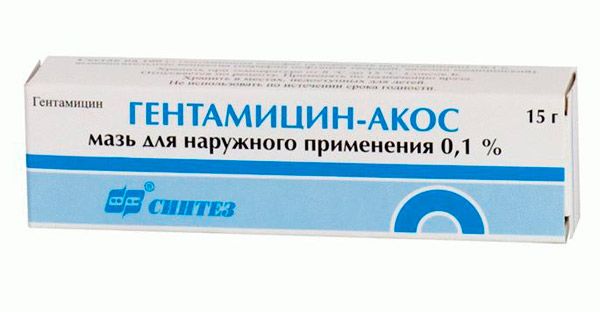
After application to the skin, it is quickly absorbed and has a wound-healing effect.
- It is used for skin damage of varying severity and etiology. It helps with surgical infections, purulent wounds, infections, dermatitis, trophic ulcers, burns. The product is applied to the affected areas 2-3 times a day, the course of treatment is 7-14 days.
- Contraindicated in case of intolerance to the active substances. Side effects are rare and manifest as skin allergic reactions.
 [ 13 ], [ 14 ], [ 15 ], [ 16 ]
[ 13 ], [ 14 ], [ 15 ], [ 16 ]
Levomycetins
- Fulevil
Suitable for the treatment of wounds of varying severity, inflammatory skin lesions, bedsores, first- and second-degree burns, and rectal fissures. The product is applied in a thin layer to a sterile napkin and applied to a pre-treated wound. Dressings are changed every 24 hours. Duration of treatment is 7-21 days. Fulevil is not recommended for use in case of hypersensitivity to chloramphenicol. It may cause transient burning and hyperemia.
- Levomekol
A combination product with an immunostimulant – methyluracil and an antibiotic – chloramphenicol. The ointment is effective against most bacteria, spirochetes, rickettsia, chlamydia, gram-positive and gram-negative, anaerobic and aerobic microorganisms.
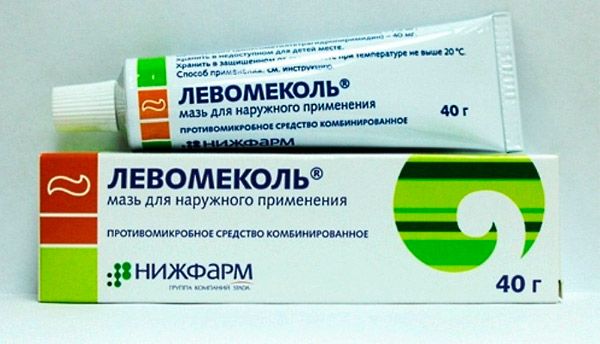
The bacteriostatic effect is based on the inhibition of protein biosynthesis in the bacterial cell. If there is pus in the wound, this does not reduce the antimicrobial effect of the antibiotic. Accelerates the regeneration process, has dehydrating properties.
- The medicine is effective for purulent wounds, burns, purulent-inflammatory dermatological diseases, trophic ulcers, furuncles. The drug is applied to sterile napkins and placed on wounds or injected directly into purulent cavities using a syringe.
- It is prohibited to use in case of intolerance to active components, during pregnancy and breastfeeding. It can cause skin allergic reactions that do not require treatment, as they pass on their own.
Lincosamides
- Lincomycin ointment
An antibiotic with the active ingredient lincomycin. It has an antimicrobial effect. It is used for purulent wounds and pustular diseases of the skin/soft tissues. Before applying it, it is necessary to clean the wound from pus and necrotic contents. The product is applied in a thin layer to the skin 1-2 times a day.
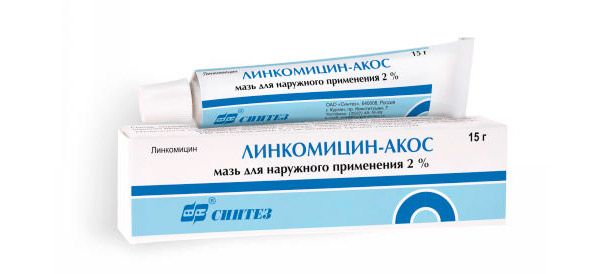
Contraindicated for use in kidney and liver diseases, with special caution in patients with a history of allergic reactions. Long-term use may cause side effects: skin rash, itching, hyperemia. To eliminate them, it is necessary to stop treatment and seek medical help.
Macrolides
- Erythromycin ointment
An effective remedy for treating infected wounds, pustular lesions of the skin and soft tissues, bedsores, mucous membrane infections, second and third degree burns, and slowly healing skin defects. Use 2-3 times a day, applying both to the wound and under the bandage.
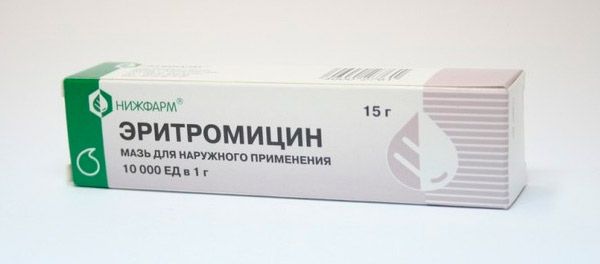
The duration of treatment is from 2-3 weeks to 4 months. Side effects are rare and manifest themselves as mild irritation.
Tetracyclines
- Tetracycline ointment 3%
Antibiotic for external use, active against many pathogens. Suppresses the growth and reproduction of bacterial cells.
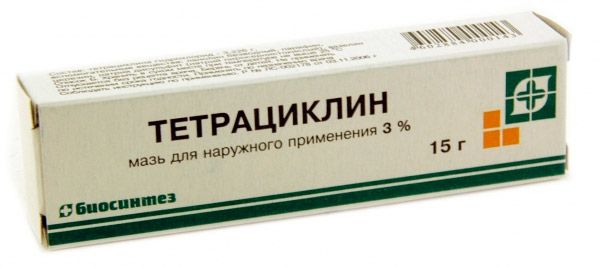
It exhibits pronounced pharmacological activity in infectious lesions of the epidermis caused by gram-positive and gram-negative microorganisms.
- Indications for use: infectious and inflammatory lesions of the skin and subcutaneous tissue, deep and long-healing wounds, eczema, folliculitis, furunculosis, acne, infections with productive purulent exudation.
- The preparation is applied in a thin layer to the affected areas, capturing some healthy tissue. Applications are made 1-2 times a day or a bandage is applied for 12-24 hours. The course of therapy depends on the severity of the wound and can last from 1-2 days to 2-3 weeks.
- Side effects manifest as skin allergic reactions: itching, burning, hyperemia. Not used in case of hypersensitivity to active components. With special caution, it is prescribed for the treatment of wounds in pediatric patients and for pregnant women.
Antibiotics of other groups
- Bactroban
An antimicrobial agent with the active substance mupirocin, a broad-spectrum antibiotic. Inhibits bacterial cell synthesis, has a bacteriostatic effect, and increased dosages have a bactericidal effect.
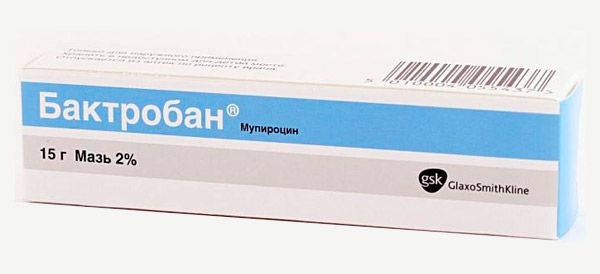
The drug is active against Streptococus spp., Staphyloccocus aureus, Staphyloccocus epidermidis and other harmful microorganisms.
- Bactroban is prescribed as a local therapy for patients with bacterial infections of soft tissues and skin. In case of secondary infected wounds, furunculosis, folliculitis and other dermatological pathologies.
- Since the product is indicated for local use, systemic absorption is insignificant. When applying the ointment to pressure bandages, the therapeutic effect increases, since the penetration of the active component into the tissues is enhanced. The medicine is applied in a thin layer to the skin up to 3 times a day. The recommended duration of treatment is 7-10 days.
- The drug is well tolerated by patients. In some cases, undesirable effects such as skin itching, burning, urticaria, dry skin, eczema, hyperemia, erythema occur. Nausea, allergic reactions and headaches are possible.
- Do not use in case of hypersensitivity to the components, for the treatment of children under 2 years of age. In case of accidental ingestion of the product, it is necessary to wash the stomach, take enterosorbents and seek medical help.
- Heliomycin
An antibiotic with a vasoconstrictor effect. Active against gram-positive microorganisms and viruses, low-toxic. Used for extensive wounds, purulent skin inflammations, infected eczemas. Suitable for the treatment of adults and infants.
Before use, it is recommended to determine sensitivity to active substances. Apply a thin layer to the affected areas 1-2 times a day for 5-7 days. The product is applied both to the wound surface and under the dressings.
- Tyrosur
Antimicrobial agent for local use. Antibacterial activity is based on cyclic and linear polypeptides that form endotoxin. Active ingredient: tyrothricin. The drug is effective against gram-positive and gram-negative microorganisms, pathogens of gonorrhea, yeast fungi, trichomonads.
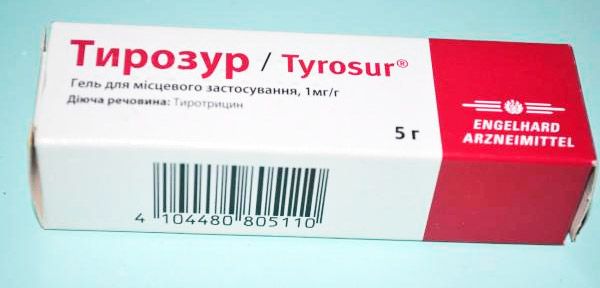
Tyrothricin destroys bacterial walls, changing the permeability of the cytoplasmic membrane, inhibiting cell division and growth.
- Effectively relieves pain, does not form a greasy film on the skin, reduces the amount of pus and exudate released from the wound. Due to this, its purification from fibrin is improved and regeneration processes are enhanced.
- Indications for use: wounds, infectious and inflammatory lesions of soft tissues and skin caused by microbes sensitive to the active substance. Helps with erosions, ulcerative defects, burns, purulent inflammations, infected eczema.
- The ointment is used externally, applying a thin layer to the affected areas of the skin 2-3 times a day, it can be applied under a bandage. It is well tolerated, in rare cases local allergic reactions (mild burning, redness) occur, which pass on their own. It is contraindicated for use in case of hypersensitivity to the components, during pregnancy and lactation.
- Fusiderm
An antibacterial drug with the active substance fusidic acid. It is active against corynebacteria, bacteroids, strains of Staphylococcus aureus, Staphylococcus epidermidis, meningococci and other infectious agents.
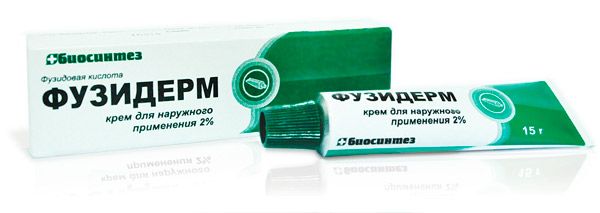
It has a pronounced anti-inflammatory, anti-allergic, antipyretic and anti-exudative effect. After application to the skin, it quickly penetrates into the deep layers of the dermis, systemic absorption is minimal.
- Prescribed for wound and infectious changes in the skin. Effective for primary and secondary pathological processes, folliculitis, dermatitis, acne, impetigo, burns. Apply a thin layer at intervals of 8-12 hours. Duration of treatment is 7-10 days. Can be used under occlusive dressings.
- Contraindicated for use in case of intolerance to fusidic acid, infectious changes in the skin caused by microorganisms not sensitive to the drug. Not used during pregnancy and lactation.
- Side effects include burning, itching, tingling and erythema at the site of application. Allergic changes such as eczema, dermatitis, and the development of atrophic changes in the skin are possible.
Antibiotic ointment for wound healing
Human skin is very often subject to all sorts of injuries, leaving wounds, scratches, cuts and other defects. In some cases, it is necessary to use medications to treat them. An antibiotic ointment for wound healing accelerates regeneration and prevents the development of infectious processes. In most cases, such products have a combined composition, so they have anti-inflammatory, antimicrobial and analgesic effects.
The medicine is chosen based on the severity of the damage. The following drugs have good antimicrobial and healing properties:
- Nitacid
A local remedy with pronounced antimicrobial properties. It contains the antibacterial substance nitazole and sulfanilamide. The components are active against a wide range of gram-positive and gram-negative bacteria, multiresistant strains. It has an anti-inflammatory, drying and cleansing effect, absorbs purulent-necrotic masses. Penetrates into the deep layers of the dermis, reducing the risk of secondary infection.
- Indications for use: treatment of infected wounds of any severity, purulent-inflammatory diseases of soft tissues and skin. The product is effective for deep burns of II-IV degree. Before applying to the skin, it is recommended to treat the wound surface with hydrogen peroxide. Can be applied both to the wound and under the bandage 1-2 times a day. The duration of treatment depends on the results achieved in the first days of therapy.
- Side effects occur due to intolerance to the active substances. Most often, patients experience allergic reactions: urticaria, contact dermatitis, hyperemia, itching, Quincke's edema. Symptomatic therapy is used to eliminate them.
- Long-term use of Nitacid may cause overdose symptoms. Such reactions occur when the medication is applied to large areas with damage to their integrity. Due to systemic absorption, itching, burning, and signs of intoxication appear.
- Rescuer
A combined preparation with synergistic properties. It has a regenerating, softening, analgesic, anti-inflammatory and antiseptic effect. It stops the inflammatory process, has a strong antibacterial effect.
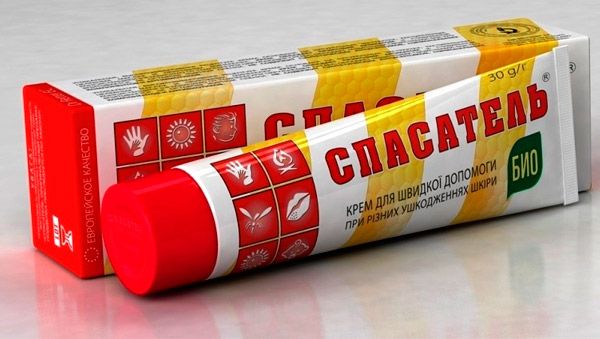
Stimulates cleansing of the wound surface and natural restoration of damaged dermis. The clinical effect appears a couple of hours after use.
- Indications for use: treatment of superficial and deep wounds, abrasions, hematomas, cracks, damage to subcutaneous tissue, burns, diaper rash, dermatitis of various origins, inflammation of the mucous membranes and skin, secondary infections.
- Before applying Rescuer to a wound, it must be washed and dried. A small amount of the product is evenly distributed on the skin and covered with a bandage to enhance its effect. The wound must be opened periodically to allow oxygen access. Bandages are changed 1-2 times a day.
- Contraindicated for use in case of individual intolerance to the active components. Side effects manifest themselves in the form of burning, itching, redness, swelling at the site of application. In addition, an exacerbation of the inflammatory process is possible when applied to chronic lesions with trophic disorders.
- Actovegin
A medicinal product for accelerating tissue regeneration and improving trophism.
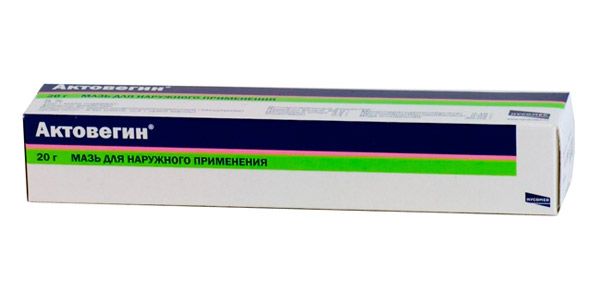
The active substance is a deproteinized hemoderivative from calf blood. The antihypoxant accelerates the metabolism of oxygen and glucose, which increases energy metabolism and accelerates the healing process.
- Prescribed for wounds and inflammatory diseases of the skin and mucous membranes. Helps with burns (chemical, thermal, solar), abrasions, cracks and scratches. Can be used for bedsores, skin damage from radiation, and weeping ulcers.
- The duration of treatment is 10-12 days, the product is applied to the skin 2 or more times a day. Bandages and gauze tampons can be used. Long-term therapy or the use of high doses provokes side effects - skin allergic reactions.
All of the above antibiotic ointments for wound healing are available without a prescription. But before buying such a product, you need to understand that home treatment is possible for small wounds, scratches, abrasions, cuts or minor burns. Larger injuries require medical attention.
The speed of healing depends on the regenerative features of the patient's body. Some diseases can provoke long healing. For example, with high blood sugar or metabolic disorders, the treatment will be long. That is why the drugs should be selected by a doctor, individually for each patient.
Antibiotic ointments for purulent wounds
A purulent wound is damage to the skin and soft tissues that are involved in an infectious process with the development of pathogenic microorganisms. Bacteria provoke the discharge of purulent masses, necrosis, swelling, pain and intoxication of the body. Such a pathological condition can be a complication of an infected wound or a rupture of an internal abscess. The risk of its development increases significantly with somatic diseases (diabetes mellitus) and in the warm season.
A purulent process develops due to infection of the wound with streptococci, staphylococci, E. coli or any other bacteria. Microbes enter the wound from dirty hands, soil, which indicates primary infection. If the rules of dressing were not followed, harmful microorganisms can penetrate the body, causing foci of suppuration - secondary infection.
If purulent wounds are detected on any part of the body, treatment must be started immediately. Inadequate or late therapy can cause serious complications (sepsis, periostitis, osteomyelitis) or the development of a chronic process. Treatment must be comprehensive and consist of the following stages:
- Removal of necrotic tissue and pus
- Relief of inflammation and swelling
- Removal of pathogenic microflora
- Stimulation of regeneration
- Detoxification and immunocorrective measures
The beginning of the purulent process is characterized by the release of exudate from the wound. This fluid contains cellular elements and bacteria. Treatment is based on constant washing, drainage and the use of antibacterial drugs that accelerate the regeneration of the skin.
Antibiotic ointment for purulent wounds stops the proliferation of bacteria, stops the inflammatory process, removes exudate, and restores damaged tissue. There are drugs of local and systemic action, they are selected depending on the severity of the lesion. Since the causative agent of the infection is unknown at the beginning of treatment, broad-spectrum medications are used: penicillins, tetracyclines, cephalosporins.
Method of administration and dosage
Since the ointment is a topical agent, this indicates that it should be applied to damaged areas of the skin. The method of application and dosage depend on the severity and stage of the wound process. As a rule, the medicine is used 1-3 times a day.
The medicine is applied in a thin layer to the damaged skin, gauze napkins are soaked in it, placed in deep wounds, or applied under a bandage. The duration of therapy is determined by the attending physician and depends on the individual regenerative characteristics of the body. On average, the medicine is used for 7-20 days, for deep and complex wounds 4-6 months.
Using Antibiotic Ointments for Wounds During Pregnancy
No one is immune from damage to the skin. If this happens to expectant mothers and there is a risk of infection, then it is necessary to choose the most effective and at the same time safe drug.
The use of antibiotic ointments for wounds during pregnancy is possible only on medical prescription. This is due to the fact that most drugs do not have reliable information about the safety of their use during this period. Some drugs of combined action can penetrate into the systemic bloodstream, having a negative impact on the development of the child's body. Most often, women are prescribed Tetracycline ointment and Levomekol.
Contraindications for use
Not all antibacterial ointments for wounds can be used independently. A quick and lasting therapeutic effect is possible if the patient has sought medical help and received recommendations or a prescription. Otherwise, the drug can cause serious complications and worsen the condition. This is explained by the fact that any pharmacological agent has contraindications for use.
Antibiotic ointments are prohibited for use in case of hypersensitivity to the active components. Some are contraindicated for pregnant women, during breastfeeding, for pediatric patients and in case of allergic reactions in the anamnesis. A number of wound-healing preparations are not used on skin with chronic infection.
Side effects of antibiotic ointments for wounds
Long-term use or failure to follow doctor's recommendations for use of the drug may provoke undesirable symptoms. Side effects of antibiotic ointments for wounds are manifested in the form of allergic reactions at the site of application:
- Burning
- Itching
- Hyperemia
- Irritation
- Increased sensitivity to ultraviolet radiation (photosensitivity)
- Contact dermatitis
- Intoxication
To eliminate these symptoms, it is necessary to reduce the frequency of application of the product to the skin or stop treatment altogether. In this case, it is imperative to seek medical help.
Overdose of antibiotic ointments for wounds
Increased dosages of any medication cause adverse symptoms. Overdose of antibiotic ointments for wounds manifests itself in the form of local allergic reactions. These symptoms are similar to side effects. Most often, patients experience itching, burning, redness and pain at the site of use.
To eliminate overdose symptoms, it is recommended to stop treatment and seek medical help. The doctor will adjust the dosage or prescribe another drug.
Interactions with other drugs
Complex therapy is indicated for effective wound treatment. This involves the simultaneous use of several medications. Interactions with other drugs are prescribed by a doctor. Based on the stage of the wound lesion and the nature of the pathological process, the doctor selects drugs that differ in form and action. This will help avoid side effects and overdose symptoms.
Very often, antibacterial ointments are combined with oral antibiotics, immunostimulants and vitamins. If there is pus in the wound, then special ointments, most often plant-based, are used to draw it out. Wound-healing drugs are prescribed to speed up tissue recovery. The main condition for interaction with other drugs is compliance with the time interval and the absence of contraindications.
Storage conditions
In order for the medicine to retain its pharmacological properties throughout its shelf life, it is very important to observe the storage conditions. The ointment should be in the original packaging, in a place protected from sunlight, moisture and inaccessible to children. The recommended temperature is 15-25 ° C.
Frequent temperature changes and light have a negative effect on the quality of the drug. Thus, an increase in temperature reduces the activity of antibiotics. In addition, stratification and loss of homogeneity of the ointment base are possible.
Best before date
Antibiotic ointment for wounds, like any other medicine, has an expiration date. As a rule, antibacterial drugs are approved for use for 24-36 months from the date of manufacture. After this period, the tube with the medicine must be disposed of. The use of expired drugs on wound areas can provoke complications and cause pathological symptoms that require medical attention.
Effective antibiotic ointments for purulent wounds
- Levosin
Antibacterial, local anesthetic. Active ingredients: chloramphenicol, methyluracil, sulfadimethoxine, trimecaine. The combined composition has an antimicrobial, analgesic, regenerative, necrolytic and anti-inflammatory effect. It is active against anaerobes, gram-positive and gram-negative microorganisms.
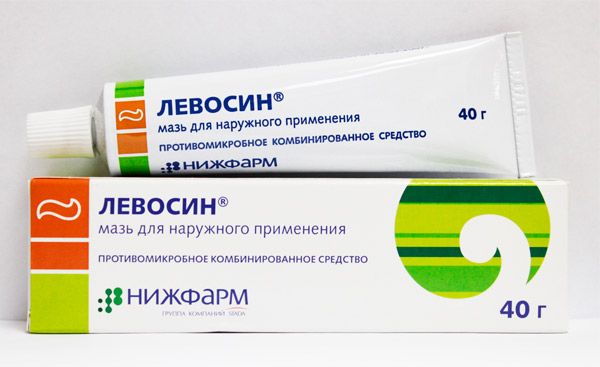
After application to the skin, it quickly penetrates into the tissues, transporting active components. Due to its hydration properties, it eliminates perifocal edema within 2-3 days, cleanses the wound, accelerates its healing and stimulates cellular protective factors. It does not accumulate and does not have a local irritant effect.
- Indications for use: purulent wounds with infected mixed microflora, burns, hard-to-heal ulcers. Not used in case of intolerance to active components, during pregnancy. Side effects are manifested in the form of skin allergic reactions.
- The preparation is applied to sterile gauze flaps and the wound is filled with them. The medicine can be injected into purulent cavities using a catheter, syringe or drainage tube. If the wounds are not deep, the ointment is applied in a thin layer to the damaged areas and covered with a bandage. Dressings should be done daily until the wound is completely cleared of pus.
- Levonosin
Antimicrobial, anti-inflammatory agent with analgesic properties. Active ingredients: sulfadimethoxine, methyluracil, polyethylene oxide and trimecaine. Prescribed for the treatment of purulent wounds in the first phase of the wound process. Contraindicated for use in case of individual intolerance to the active substances.
Before applying the medicine to the skin, it is recommended to determine the sensitivity of the microflora that caused the pathological process to it. The product is applied directly to the skin and under the bandages, gauze napkins are soaked and the wound is filled with them. Dressings are done daily until the wound is completely cleansed.
- Dioxin (dioxidin)
Antibacterial pharmacological agent, quinoxaline derivative. Has a broad spectrum of action, is active against many harmful microorganisms.

It does not have a local irritant effect, but can cause drug resistance in bacteria.
- Indications for use: wounds with deep purulent cavities, pustular skin diseases, wound and burn infections of various localizations and complexity, long-term non-healing wounds and trophic ulcers.
- The medicine is applied in a thin layer to the skin cleared of purulent-necrotic masses; ointment wipes or bandages can be used. Deep wounds are tamponed. The duration of therapy is 14-20 days. It is not prescribed for the treatment of pregnant women and newborns.
- Contraindicated for use in case of hypersensitivity to active substances. Side effects manifest themselves in the form of skin irritations and allergies.
Multicomponent ointments are widely used to treat suppuration. Such products have an anti-inflammatory effect, improve local blood circulation and stimulate the restoration of the skin: Oxycyclozole, Oxyzone, Vishnevsky's balsamic liniment, Mafenit-acetate, Levometoksin. Particular attention should be paid to topical preparations for drawing out pus: Ichthyol, Syntomycin, Streptocide ointment, Levomekol.
Attention!
To simplify the perception of information, this instruction for use of the drug "Antibiotic ointments for wounds" translated and presented in a special form on the basis of the official instructions for medical use of the drug. Before use read the annotation that came directly to medicines.
Description provided for informational purposes and is not a guide to self-healing. The need for this drug, the purpose of the treatment regimen, methods and dose of the drug is determined solely by the attending physician. Self-medication is dangerous for your health.

